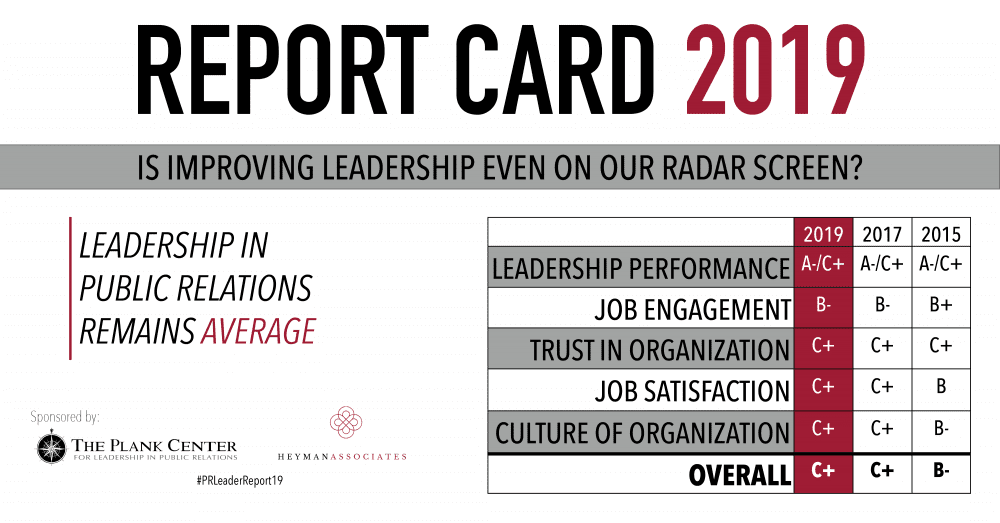 Is improving leadership even on the radar screen in our profession? The short answer to that question appears to be no, according to the results of the Plank Center’s Leadership Report Card 2019. Though numerous blogs, articles and research studies in our field recognize the importance of improving leadership to help the profession achieve positive outcomes, we struggle to make it happen.
Is improving leadership even on the radar screen in our profession? The short answer to that question appears to be no, according to the results of the Plank Center’s Leadership Report Card 2019. Though numerous blogs, articles and research studies in our field recognize the importance of improving leadership to help the profession achieve positive outcomes, we struggle to make it happen.
Our Leadership Report Card 2019 conveys the responses of hundreds of public relations professionals in dozens of organizations nationwide. Three-quarters (74.7%) of them are either the No. 1 (35.1%) or No. 2 (39.6%) communication leader in their organization. Based on the input of these seasoned respondents, public relations leaders received an overall grade of “C+” in 2019, similar to our 2017 study (a “C+” grade) but a continued downgrade of the score from our 2015 study (a “B-“ grade). Such results confirmed both the need for improved leadership and the challenge of how to get there.

Three crucial points are worth highlighting and call for action for improvement:
- There are sharp perceptual differences between top leaders and their employees on leadership performance;
- There are prevalent gender gaps in workplace culture and practice; and
- There are growing numbers of actively disengaged professionals in the field.
In all five fundamental areas of leadership we investigated—organizational culture, quality of leadership performance, trust in the workplace, professionals’ work engagement, and job satisfaction—there were statistically significant differences based on place in the organizational hierarchy. Top leaders rated themselves much higher than professionals at lower levels did. These deepened perceptual gaps were also identified in the Plank Center’s North American Communication Monitor 2018-2019 released earlier this year.
Such consistently disappointing patterns over the years and across Plank Center studies present persuasive evidence that improving top communicators’ leadership performance needs to be a priority in public relations. Leaders shouldn’t just assume employees understand their viewpoints. Leaders should strive to create a culture that fosters mutual understanding. It is senior leadership’s responsibility to make sure that modeling behaviors and actions are well communicated to and understood by employees at all levels. Building a culture for communication will enhance the positive effect of information sharing and receiving, and ultimately will minimize the perceptual gap in leadership performance.
Secondly, gender gaps are prevalent. Women in public relations remain less engaged, less satisfied with their job, less confident in their work cultures, and more critical of top leaders than are men. Even more concerning to our profession should be the continuously dropping grades women show in workplace trust. Women were significantly less trusting of relying on their organization to keep its promises, take opinions of employees like them into account when making decisions, and treat them fairly and justly. Such gender gaps deepened over the past six years. As a profession in which women comprise nearly 75% of the jobs at all levels, what can we actually do to bridge these gender gaps?
The gaps may be reduced through continued and sustainable efforts in: 1) increasing power sharing by providing concrete plans and cases; 2) encouraging employees to freely speak up without fear of retribution; 3) fostering two-way and multiple channels for communication; 4) sharing decision-making in teams and units through collaboration; and 5) bringing employees from diverse groups in to develop solutions. To push for real changes in bridging the gender gaps, persistent actions are needed.
Despite the aforementioned perceptual gaps, it turns out that the percentages of actively disengaged groups among top leaders, especially women, are increasing. The percentage of actively disengaged women leaders nearly doubled, rising from 5.1% to 9.6%. Meanwhile, the percentages of actively disengaged employees also gradually grew. On average, nearly one in 12 professionals identified herself or himself as actively disengaged.
If employee engagement is a strong indicator of organizational performance, the reduced levels of engagement among PR professionals in our study raises a serious concern, which may explain why PR leaders received an average grade in leadership performance when evaluated by their employees. Our findings from three Report Cards confirm the quality of leadership performance strongly influences employees’ engagement through top leaders’ communications, behaviors, and decision-making.
None of this is easy to do but PR leaders carry a long-term responsibility to lead the changes and push for real improvements. With the reality that the power of stakeholders has increased over the years due to rapid technological changes and global market shifts, the need for excellent leadership performance is stronger than ever. These changes make improving public relations leadership an essential priority.
* To know more about the study, please download and read the Leadership Report Card 2019.
![]()
 This blog post was provided by Juan Meng, Ph.D., University of Georgia; and Bryan H. Reber, Ph.D., University of Georgia.
This blog post was provided by Juan Meng, Ph.D., University of Georgia; and Bryan H. Reber, Ph.D., University of Georgia.



